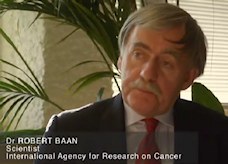 |
 |
|
 |
 |
About Us | Contact |
|
|
11/11/2014 - Microwaves, Science and Lies A provocative documentary entitled "Ondes, Science et Manigances" (Microwaves, Science and Lies) has recently been produced, challenging alleged corruption in the World Health Organisation. It criticises their stance and official literature on the potential health risks of mobile phones and radiofrequency electromagnetic fields, particularly Factsheet No. 193. The video, researched by Nancy Meritens, directed by Jean Hèches and supported by SkyVision Solutions, can be rented from Vimeo in English for just five US dollars, and includes a number of interviews with leading scientists and others involved in EMF research. The underlying message of the video is that WHO are not reflecting the current position of the science. For example, they refer only to mobile phones in their factsheet, which is disingenuous to the considerable amount of research on other radio-frequency (RF) sources that the International Agency for Research on Cancer (IARC) collated when producing their 2011 monograph.  Furthermore, they strongly downplay the evidence on mobile phones and cancer by using the spin word "established", as reflected in their statement "To date, no adverse health effects have been established as being caused by mobile phone use" in factsheet No.193. Not only is the scientific benchmark for "established" very high (and considerably higher than the threshold used to set other safety standards such as food additives in processed meals), but it also presents a picture that is at odds with the latest 2011 IARC 2b classification of RF fields. According to Dr Robert Baan, the officer responsible for IARC's monograph 102 on RF fields, the factsheet wording could easily be misinterpreted as a stamp of safety for mobile communication technology. He has raised this issue with WHO and suggested an alternative wording, but no response or alterations have been forthcoming. Another interesting issue raised by the video is that the authorship of WHO factsheets is very unclear. Whilst engineer Emilie van Deventer admits being in charge of the contents of factsheet 193 and consulting other experts to approve its content before publication, she would not name those experts, describing the document as "a corporate view". This is an issue that requires attention as the factsheet is cited by the industry globally as a rubber stamp of safety, and knowing the factsheet's authorship is a critical part of maintaining the credibility and transparency of their review process. IARC produced their full Monograph in 2013. An electronic copy of the 430-page document is freely available (see links at bottom of this page). The basis for IARC designation of RF as a Class 2B carcinogen is summed up in one sentence: "Positive associations have been observed between exposure to radiofrequency radiation from wireless phones and glioma and acoustic neuroma" (p.421). Those associations with brain tumors and tumors of the acoustic nerve were observed by the Interphone study group and Lennart Hardell's team in Sweden. The panel's decision was close to unanimous.  We find these signs of internal division between IARC and WHO very concerning. We find these signs of internal division between IARC and WHO very concerning.
 IARC currently has the most thorough and comprehensive method of assessing the causes of cancer, and we agree that the official WHO material on RF and health does not match the current state of the science.
IARC currently has the most thorough and comprehensive method of assessing the causes of cancer, and we agree that the official WHO material on RF and health does not match the current state of the science.WHO even ignored Dr Robert Baan's request to revise the misleading wording, WHO have not done so. Which people were responsible for adding that sentence (see above) that the mobile industry throughout the world now quote on their websites (etc) as showing that mobile phones are safe?
Edited 26/02/2015; IARC 2011 not 2013; Alhbom and Schütz detail changes. Links» World Health Organisation |


I have just paid $5 and watched this excellent professional 93 minute documentary (in English). It is by far the best investigative over-view of the non-ionising and health debate from the 1940s to the present day. The "presenter" who appears most is Mona Nilsson, and she helps to show why the science is so distorted. There are many other people interviewed including scientists and MEPs. The film contains an amazing selection of video clips from a period of some 60 years - if you know where to look you can even see Powerwatch's Graham Lamburn and myself in some of the shots of the November 2011 Brussels SCENIHR two-day meeting on EMF and Heath. If you are interested in the subject of EMF/RF and health then this really should be a "must see film" - even if, like me, you have studied the facts and issues about it over many years. Well worth paying a small sum to support and enjoy such excellent work. The content is insightful, informative and very concerning.